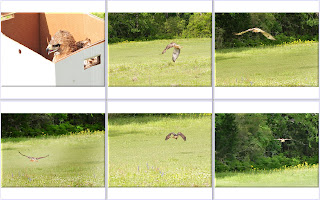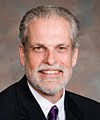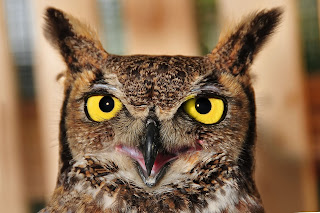AMA chief's passion for health care extends to birds

(POSTED: 5/17/10) Dr. J. James Rohack is president of the Chicago-based American Medical Association, and was deeply involved in health care reform.
But his passion for medicine extends beyond people -- to raptors.
When he's not on the job, he's home on his Bryan, Texas, ranch helping his wife, Charli, run a rehabilitation center for injured and sick birds of prey, from hawks and eagles to owls.
"When we look at, you know, the wildlife, it's different than a domesticated pet where you have an owner that is responsible for them," Rohack (pictured below) told ChicagoWildlifeNews.com in a recent interview about his animal patients. "The question is, who's responsible for the wildlife? And in some respects, all of us are."

What follows is an edited transcript of the interview:
Q: How did this wildlife rehabilitation center (called the Eyes of Texas) come into being?
A: In 1993, my wife and myself moved to a 23-acre ranch in Bryan, Texas, and that's
about a 10-minute drive from Texas A&M College of Veterinary Medicine.
My wife began raising exotic ducks and geese on our three-acre lake and as a result she would interact with the vets at A&M in zoological medicine. They had mentioned that they really needed to have a place to allow animals that were injured to be rehabilitated, because they didn't have the facilities. And so my wife, who is not a physician, went and got some educational training so that she could be a wildlife rehabilitator.
We have a very good partnership with the veterinary medical school. We have interns and residents that will come out along with students at A&M to do internships at our rehabilitation center.
In the beginning, a decade ago, she would do all of the wildlife, but over the last four years, she has specialized mainly in birds of prey. Those are the hawks, and the owls. The permits that she has are not only for the state of Texas, but also the U.S. Fish & Wildlife permits, too.
Q: Why did you decide to invest in this?
A: The reality is we're all on the planet and all animal species interact with each other, one way or another. When we look at, you know, the wildlife, it's different than a domesticated pet where you have an owner that is responsible for them. The question is, who's responsible for the wildlife? And in some respects, all of us are. As man encroaches upon the natural areas where the wildlife live, then they wind up not having a habitat and sometimes developing injuries with a direct relationship to humans. For example, with the hawks and the birds of prey, one of the major injuries is motor vehicle trauma.
Q: What are the most common injuries?
A: Where we live in central Texas is a large migratory bird place for birds coming from the North, migrating down into Mexico and Central America, so the injuries that we tend to see for the birds of prey are really two-fold. One are the adolescent birds that become tired and aren't eating well, and as a result of that become somewhat malnourished, and then the other one is cars. And the trauma is not only motor vehicle trauma, but it is also, regretfully, humans are shooting at these birds of prey.
The birds of prey are protected under federal law, the migratory bird pact, but it's tragic when one sees an injured hawk or an eagle that is brought in because somebody has taken a potshot at it, and isn't aware of the, or perhaps is aware, of the nature of the devastation that they are doing to the ecosystem when they take out the bird of prey.
Q: What animals do you rehabilitate most often?
A: Where we are, the types of birds we've had are the red-shouldered hawk, the red-tailed hawk, Mississippi kite, the Cooper's hawk. We've also had the owl species. The small screech owls, the great horned owls, and barn owls. We also get three different species of vultures. We have what's called the Mexican vulture. The turkey vulture, and then we also have had the Mexican caracara. The caracara is a raptor that is actually the national bird [of Mexico.] When you look at a flag of Mexico, it's the caracara. The blue heron and the great heron as well as -- I've mentioned we've had some eagles, usually two or three a year that are brought in because they've been shot or occasionally, it's because they've developed an infection.

Q: Tell me about the release process?
A: Usually, what happens is that we try to find where these birds have been picked up because if they are not a species that's traveling, for example a bird of prey that has a mate for life, then once we've rehabilitated, we want to release it back to that same area.
Owls, we tend to release at night, hawks you tend to release early in the morning . . . and of course, through the federal and the state requirements, my wife has to keep track of every animal that she's cared for. What happened to them, in other words, were they released back to the wild, are they not able to survive, or were they transferred to another rehabilitator?
There are some rehabilitators that specialize in particular birds. For example, there's a bird called the nighthawk. The nighthawk, as you'd expect by its name, hunts at night and usually eats insects. It eats when it's flying. So when you're feeding a bird like that and trying to train it to eat, you have to have a specialized way to allow them to eat, while flying.
Q: How is it run? Who runs the day-to-day operations?
A: The day-to-day running is my wife, as the director. This is all volunteer work. There are no grants, there is no money [from others.] . . . We went through a time when we could get volunteers to help, but . . . when you're talking about birds of prey, these are animals that could potentially harm you and so, you have to have people that are really dedicated and wanting to do that. And sometimes, especially when you talk about college students, they really can't be able to devote the time, or we get some very good volunteers, but they wind up graduating after a couple of years. That's just the way the things work.
My wife gets up at about 5:30 in the morning, goes over to the rehabilitation center, which is a double-wide mobile home -- we call it our nursery -- where she prepares food for the day.
Q: Do you find you medical skills come in handy when dealing with some of these birds?
A: Yeah, they do. There have been times where, when animals come in, they need to get injections or if they have particular wrappings of something that's broken. . . .
Obviously, this year as the president of the American Medical Association, I haven't been there to help her on a day-to-day basis because of my travels, but when I'm there, I do try and help as much as I can.
Q: Are you involved in any wildlife-related activities in Chicago?
A: Actually no, because my travels to Chicago tend to be very focused on meetings. . . . Probably the thing I enjoy about Chicago the most is the downtown area, you know, being right on the lakefront. You have the opportunity to walk along Grant Park, to walk along the Shedd Aquarium and the Planetarium. So, you're . . . next to the big skyscrapers, but you're still close to nature.
By Michaela Ehimika, for ChicagoWildlifeNews.com
Contact: [email protected]
Photos: Top picture shows a red-tailed hawk being released into the wild after being treated for a fractured wing. Bottom picture shows a great horned owl that was treated for a bacterial infection, and also was released. All photos courtesy of the Eyes of Texas.


0 comments: